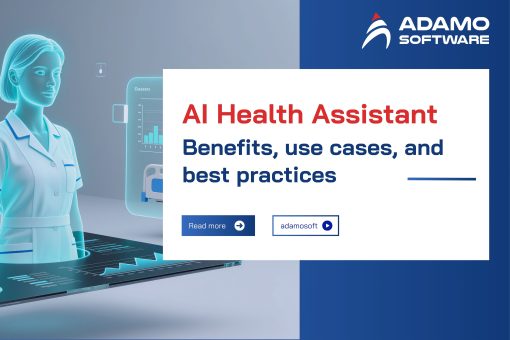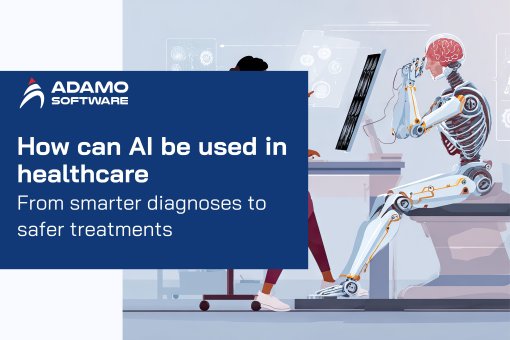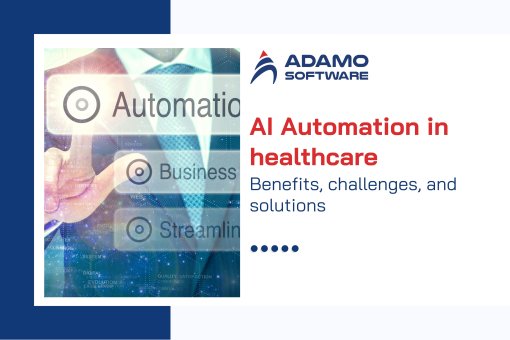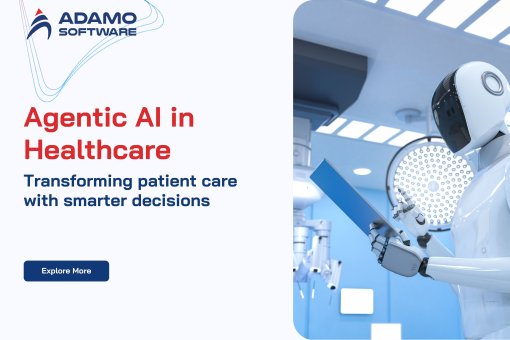Medical Device Integration Software: From Basics to Implementation
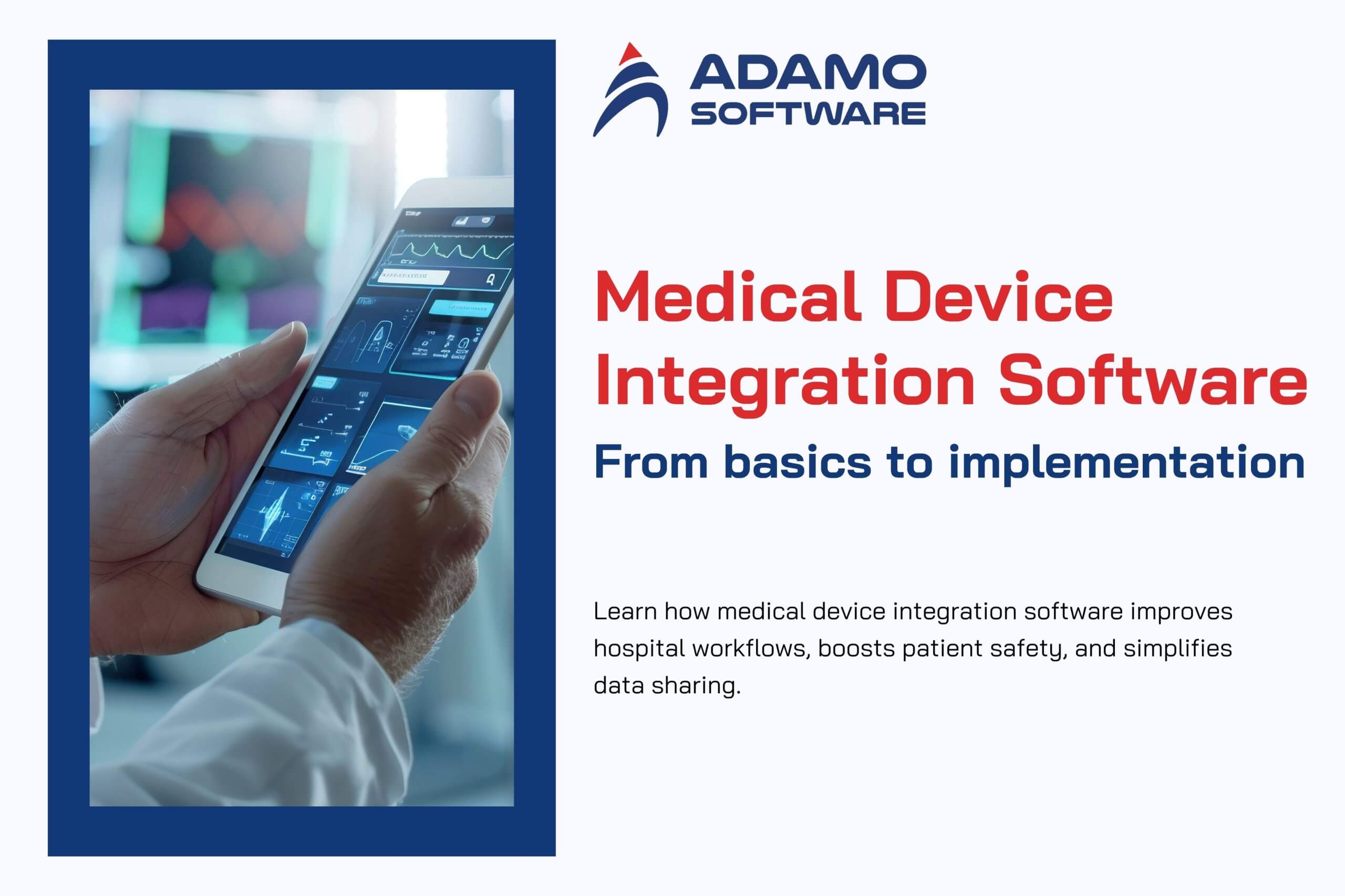
Organizations must seek to improve their patients’ health without raising costs and ensure their operations are more efficient. The increase of electronic devices in hospitals and clinics has made managing patient details more difficult. This integration software lets you link all your medical devices and have data transferred automatically.
Through medical device integration software, paperwork is lessened, and mistakes are reduced. It ensures that important patient readings from various devices are transferred automatically into electronic health records. It helps save time and allows faster decisions using data at the point of care.
As healthcare relies more on technology, businesses looking to deliver accurate and efficient care consider medical device integration software an important expenditure. This article discusses what medical device integration software is. We will share practical examples, examine benefits and issues, and outline how to apply them. We also explain how Adamo offers help.
I. What is Medical Device Integration Software?
The medical device integration software connects medical devices to the main network or EHR system used in the hospital. It supports gathering vital health data from observers, machines, and other sources. Medical installations use integration software to enable bias and systems to cooperate. Medical device integration software records this in the case’s online health records. This helps save time and prevent errors, as people no longer have to type in information manually.
Most hospitals have equipment from various vendors that cannot communicate with one another. Medical device integration software brings together hospital IT and the different devices within a hospital. It collects, sorts, and shows the data in a format doctors, nurses, and others can understand for use in healthcare.
Let’s look at what medical device integration software is responsible for:
- Gather data from various machines in patient rooms or critical care areas.
- Ensure that the information is formatted consistently for any system to use.
- Transfer the patient’s history directly to the EHR or other hospital records software.
- Automate the collection of data and cut down on human errors.
- Enable staff to make faster decisions because they have the most recent patient details.
- Increase the safety of patients through the use of accurate and up-to-date information.
- Help in complying with the rules and set guidelines of medical data and reporting.
- Cover products from various manufacturers and under different brands
The hospital needs medical device integration software to deliver better care and cut expenses. It allows the two teams to cooperate and coordinate their efforts. Healthcare is becoming smarter, safer, and more connected, thanks to medical device integration software. With medical device integration software, healthcare providers can concentrate more on their patients and less on documentation.
II. Examples of Medical Device Integration
Medical installations use integration software to enable bias and systems to cooperate. This helps decrease mistakes, increase efficiency, and provide medical staff with recent information. Here are several cases that demonstrate how medical device integration software is used.
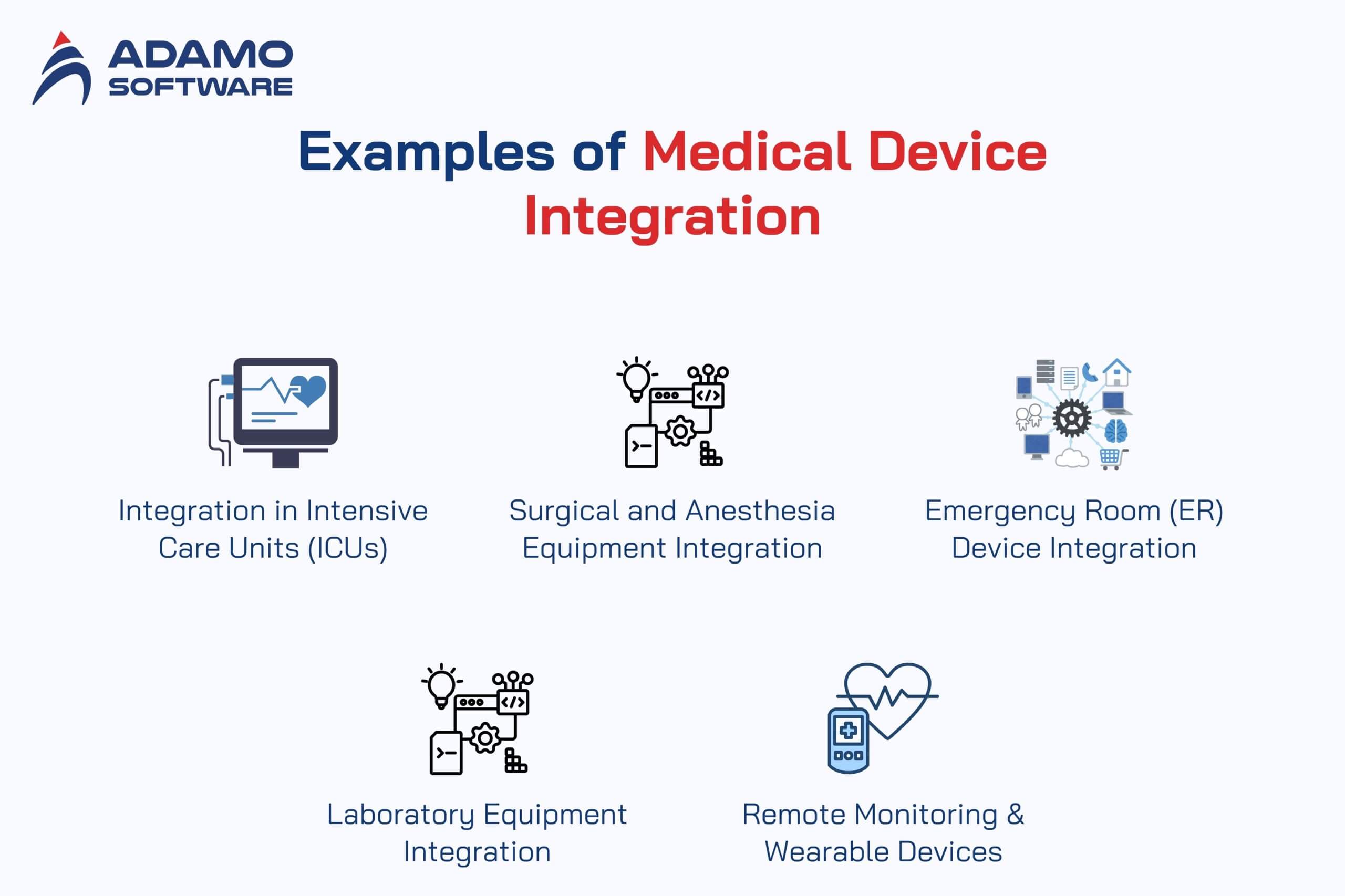
1. Integration in Intensive Care Units (ICUs)
Heart monitors, ventilators, and blood pressure machines are some devices connected to ICU patients. All devices generate important information every second. Without integration, nurses would have to copy the numbers out by hand or enter them manually.
When a medical device is linked with the latest software, all collected data is uploaded directly into the patient’s EHR. As a result, doctors get all the latest and important details about the patient. It makes it faster to process data, giving staff a chance to devote more attention to their patients.
Ready to Outsource?
Discover how we can transform your business with expert IT solutions.
2. Surgical and Anesthesia Equipment Integration
It is essential to monitor the breathing, oxygen, heart rate, and the patient’s blood pressure during any surgery. Gathering data through anesthesia machines is important, although the crew must see it quickly.
Medical device integration software allows the hospital’s system and anesthesia equipment to share real-time data for everyone on the team. It gathers information that can be reviewed and used for reporting. It increases safety in the operating room and aids in arranging a proper recovery process.
3. Emergency Room (ER) Device Integration
Time is crucial in the ER. Patient assessments are made possible by tools such as ECG machines, vital sign monitors, and portable imagers. Any detention in participating in the data may beget a detention in treatment.
Medical device integration software helps ensure that information from various devices reaches the hospital’s central systems directly. As a result, doctors can move faster and with greater confidence since everything is straightforward in their system.
4. Laboratory Equipment Integration
These machines allow technicians in medical labs to conduct blood tests, urine tests, and other tests. Putting in test results by hand is not quick and may result in errors.
Now, medical integration technology transmits the lab test results to a person’s digital record. Physicians can check them on their monitors and respond faster. As a result, the accuracy of information is increased, and all patient records are well-organized and always current.
5. Remote Monitoring and Wearable Devices
Nowadays, many individuals keep track of their heart rate, blood pressure, or blood sugar levels at home using wearable devices. Thanks to these tools, doctors can provide care to their patients other than in the hospital setting.
Remote medical devices and software can automatically transfer the data to the clinic. A patient’s glucose meter could send all the readings to their doctor for remote monitoring. As a result, chronic illnesses can be better handled, helping patients improve.
Medical device companies rely on integration software to ensure better interaction between the devices and systems they use. When healthcare providers use medical device integration software, they can save time, avoid errors, and ensure higher-quality, more efficient care.
You can explore more about What is remote patient monitoring? Tech stacks and real-life examples here.
III. Benefits of Medical Device Integration Software
This software makes healthcare providers’ work easier and more effective. It allows hospital systems to talk directly with various medical devices and receive their data. This makes things more efficient, safer, and better for patients. The advantages mentioned are explained further below.
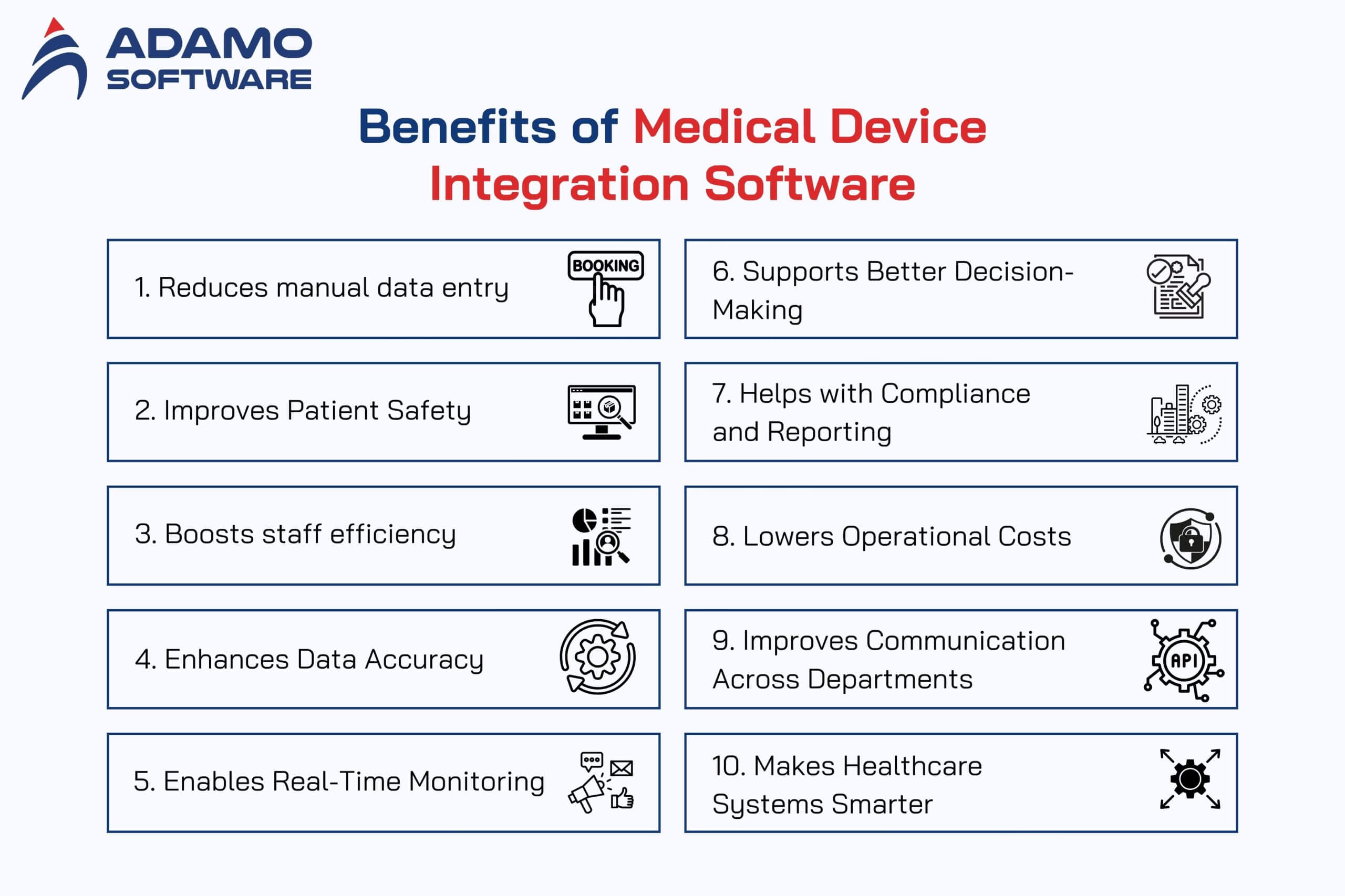
1. Reduces Manual Data Entry
In several hospitals, staff enter data from medical monitors and machines into the electronic record for each patient. Doing this kind of work is very slow and demanding. It also means there could be more mistakes.
The software resolves this issue by transferring information from the device into the system automatically. Staff can spend further time looking after cases, since they spend less time handling paperwork.
2. Improves Patient Safety
When a patient’s health records are incorrect or arrive late, safety in treatment is at risk. If the nurse makes a mistake in recording blood pressure, the doctor might prescribe the wrong medication.
Having integration software for medical devices ensures the information is always up-to-date and accurate. It instantaneously updates the patient chart, allowing healthcare professionals to respond and decide quickly.
3. Boosts Staff Efficiency
Many healthcare workers feel stressed since they must look after patients and perform various tasks that keep the system running. When the data is recorded automatically, medical device integration software helps staff save time to attend to their patients.
With such a setup, they can complete more work faster. Teamwork among staff is promoted since all information is displayed and available to everyone.
4. Enhances Data Accuracy
Any data entry errors can bring big troubles. A tiny mistake, such as swapping a number or putting the decimal in the wrong spot, can alter a patient’s diagnosis.
For this reason, medical device integration software removes the risk, as the right information is retrieved directly from the device. It ensures patients’ vital information is well-kept and valid. Using an EHR, caretakers can monitor a patient’s health over a longer period.
5. Enables Real-Time Monitoring
Continuous monitoring is needed in ICUs and emergency rooms because a patient can show signs of worsening very rapidly.
The software makes sure that connected machines transfer relevant information in real time. As a result, doctors and nurses notice any changes in the patient right away and can take action immediately.
6. Supports Better Decision-Making
If information is dispersed in various systems and written at different locations, it can be confusing to make sense of it all.
With medical device integration software, all the data from your devices is grouped in an easy-to-understand way. For doctors and specialists, this brings all their information together, aiding in making quicker and more effective treatment strategies.
7. Helps with Compliance and Reporting
To maintain the safety and confidentiality of patient information, hospitals are expected to follow healthcare laws like HIPAA.
With the use of medical device integration software, accurate records are created, and the security of patient information is ensured. Bookkeeping simplifies preparing reports for audits, claims, and performance reviews.
8. Lowers Operational Costs
Repetitive work and projects take time and resources away from a business. Errors might require the patient to stay in the hospital longer or to receive additional care.
Software for integrating medical devices reduces these costs because it makes daily work more efficient and prevents errors. It helps save money by cutting back on paper files and unnecessary repetition of tests.
9. Improves Communication Across Departments
Each department may use a variety of technologies. The result may be incorrect or confused information and delays in sending it.
This software sends data from all medical devices to one place that everyone involved can view. This ensures that doctors, nurses, lab staff, and other groups get the same information.
10. Makes Healthcare Systems Smarter
Hospitals are adopting technology changes. They should have systems that can develop as their needs change.
Medical device integration software plays a major role in this new development. It makes it easier for a hospital to operate smoothly, and medical care can be delivered faster and more effectively.
Medical device integration software contributes to making healthcare safer, quicker, and more efficient for providers. It benefits the patient and the medical team by allowing information transfer to be simple, correct, and automatic.
IV. Challenges of Medical Device Integration
Even though medical device integration software is beneficial, some issues come with it. Sometimes, hospitals and clinics come across difficulties linking different medical devices to their system. Understanding the important challenges helps you prepare for a successful integration project.
1. Device Compatibility
Numerous hospitals have several medical sources, all from different manufacturers. They operate with various data types, how information is sent, and in different formats.
Software can link to all standard machines, but it can be a struggle to compile the code they need. At times, custom code is necessary when connecting devices that are not widely used.
2. Data Security and Privacy
All measures should be taken to safeguard patient data. Any method to move sensitive health information should comply with regulations like HIPAA.
It is essential for integration software in the medical industry to provide data encryption, user access controls, and audit logs. If companies do not secure their systems appropriately, they are more exposed to hackers or data breaches.
3. High Implementation Costs
Integration software needed for medical devices is often costly to set up. Sometimes, you’ll need to get new equipment, work with consultants, or update what you already have.
Some smaller hospitals or clinics cannot afford to implement these technologies. Support and upkeep may become more expensive with time.
4. Workflow Disruption
When an organization is being integrated, it can affect how the hospital usually works. Staff members could be required to halt using some equipment or modify their approaches to it.
Applying medical device integration software should be done cautiously to avoid disturbing the delivery of patient care. Training on the new system should be provided.
5. Lack of Standard Protocols
Each country can have its way of linking medical devices. While some devices meet the HL7 or FHIR standards, many older or custom methods are also used by many devices.
The software for integrating medical devices should be able to handle many types of protocols. This increases the effort and time it takes for the two businesses to become one.
6. Maintenance and Updates
Technology evolves rapidly, and we often see new devices or systems being released.
The software should be up to date to maintain compatibility and ensure security. Updates, issues, and bug fixing are managed by the hospitals’ IT teams whenever they arise.
7. Vendor Cooperation
Often, manufacturers of devices do not grant full rights to their systems and data formats. This increases the complexity of including their products in the system.
If the vendor does not support integration efforts, medical device integration software projects may experience delays.
Ready to Outsource?
Get top-tier IT talent without the hassle. Contact us now!
8. Data Overload
With several devices linked together, the flow of data becomes very swift.
It should be possible for the software to process this data quickly and without losing any essential updates. Systems guarantee that staff are not given a flood of raw data by arranging and sorting the information.
Nonetheless, using this type of software for medical devices is beneficial. Proper preparation and selecting the appropriate tools allow healthcare organizations to fix these challenges and create a more streamlined system.
V. Steps involved in implementing Medical Device Integration Software
Medical device integration software must be installed after a meticulous plan and several major steps are set. With each point checked, licensed clinicians guarantee that everything works as it should and that data is properly protected. To ensure the project is successful, healthcare organizations should follow these guidelines.
1. Assess Needs and Set Clear Goals
The first step is for hospitals to decide what they want to achieve using medical device integration software. One must identify which machines to connect, which information should be shared, and what goals will be achieved. Establishing clear objects ensures that the design moves forward efficiently.
2. Evaluate Current Devices and Systems
Hospitals should verify that their existing medical devices and IT systems are capable of integration. Some older medical devices may not work with the newest software used today for integration in health care. Based on this evaluation, it is clear whether new devices or updates are required to ensure the system blends well.
3. Choose the Right Integration Platform
A variety of medical device integration software is available for purchase. It is necessary to pick a system compatible with the hospital’s resources, adheres to security rules, and matches the hospital’s finances. A strong platform can acclimatize to new conditions and bias.
4. Develop Custom Interfaces and Connectors
Because medical devices communicate in several ways, custom bridge code might be necessary. These tools ensure that the devices communicate using the integration software. Talking with device manufacturers and IT specialists is required.
5. Conduct Thorough Testing
Testing is necessary to guarantee that the medical device integration software works properly with other devices. Tests ensure that data is sent safely, securely, and without experiencing any delay. By detecting issues at the testing phase, you avoid facing them when using the system live.
6. Train Healthcare Staff
Using medical device integration software is essential, even for top-notch applications. The staff needs to understand how the system works, know when to pay attention to alerts, and address simple challenges. When trained, workers make smaller mistakes and feel more at ease with the recently introduced technology.
7. Deploy the Software Gradually
Deploy the medical device integration software gradually after conducting and reviewing testing and training. Performing changes gradually ensures the hospital can handle issues that may appear when the process is fully rolled out. It also helps prevent delays in serving patients.
8. Monitor Performance and Maintain the System
You should keep an eye on your application after it has been deployed. Hospitals have to evaluate the system’s functioning, frequently update the integration software, and address any glitches quickly. Updating devices and installing new software is also part of maintenance for a network.
9. Ensure Data Security and Compliance
Putting security measures on data should be the best concern as you implement the solution. The platform should ensure patient information is protected with encryption, user privileges, and frequent audits. To avoid facing legal and financial issues, it is necessary to follow healthcare regulations.
10. Plan for Future Growth
The technology used in healthcare is always developing fleetly. The software for medical device integration supports new devices or updates at any time in the future. If planning is done early, hospitals are more effective and efficient as time goes on.
Carrying out the steps ensures healthcare providers can use the software successfully. It makes certain that devices work well together, secure personal records, and invite better care. For a smooth integration process, you should pay attention to planning, testing, training, and maintenance.
VI. How Adamo can help

At Adamo Software, our medical device integration software is designed specifically for healthcare providers and is dependable and user-friendly. Connecting several medical devices is not simple for hospitals; therefore, our solutions are intended to make it easier for them. Ensure the patient database is secure and correctly transferred to every system using our software.
We partner with your team to tailor and create medical device integration software compatible with your existing equipment and routines. We continue to guide and assist your team, ensuring they have enough knowledge to work with the system. As a result, work becomes more effective, and quality care for patients starts right away.
Selecting Adamo is like choosing someone who has your healthcare organization’s success. With our healthcare software development, you can provide outstanding patient care and reduce work-related problems.







